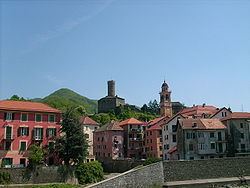Elevation 342 m (1,122 ft) Time zone CET (UTC+1) Area 23.8 km² Local time Tuesday 5:13 PM | Demonym(s) Campesi Postal code 16013 | |
 | ||
Weather 14°C, Wind N at 26 km/h, 25% Humidity | ||
Campo Ligure is a comune (municipality) in the Province of Genoa in the Italian region Liguria, located about 37 kilometres (23 mi) northwest of Genoa.
Contents
- Map of 16013 Campo Ligure Genoa Italy
- Geography
- History
- Economy
- Twin towns Sister cities
- Events
- Main sights
- References
Map of 16013 Campo Ligure Genoa, Italy
Campo Ligure borders the following municipalities: Bosio, Masone, Rossiglione, Tiglieto.
Geography
It is located in the center of the intersection of the rivers Stura, Angassino and Ponzema, 25 kilometres (16 mi) from Genoa, and part of its territory to the west is within the boundaries of the Parco naturale regionale del Beigua, while in the east borders the Parco delle Capanne di Marcarolo.
History
The place name refers to a 3rd-century A.D. Roman fortified settlement under the leadership of Emperor Aurelian., reinforced by the Byzantines in the 6th century. The first parish, San Michele, is probably dating back to the 10th century. Between the 12th and 13th century various families take turns leading the administration of Campo, until the year 1329, when Campo becomes a small fief of the Holy Roman Empire, surrounded by the territory of the Republic of Genoa.
In July 1600 the Republic of Genoa increases control of the small enclave, so that local rebels to its dominion are forced to surrender and be banished. The 18th century is full of events in Campo’s life: suffering floods, involved in political struggles between Vienna and the Republic of Genoa, the town sees a gradual buildup of manufacturing activities (iron production and processing, silk spinning mills, paper mills, lime pits, forestry and agriculture) and eventually the birth of the republican municipality that joins the Ligurian Republic in 1797.
In 1805 the town, then called Campo Freddo, is part of the French Empire of Napoleon I; after the 1815 Congress of Vienna it becomes part of the Regno di Sardegna.
In 1884 the village’s name is changed from Campo Freddo (derived from “feudo” -fief- or possibly the German word “frei” -free- ) to Campo Ligure. That year also sees the opening of the first goldsmith shop dedicated to filigree.
Economy
The country's economic activity is mainly connected to the processing of filigrana and crafts and the textile industry and mechanical engineering.
The filigrana (filigree) is very fine gold and silver threads, hand crafted using simple pliers (the “bruscelle”) and a welding torch: filigree is the centerpiece of typical Campo Ligure craft. The first shop was opened in 1884; then in a short span of time the town became the national center for this precious artistic production.
Twin towns — Sister cities
Campo Ligure is twinned with:
